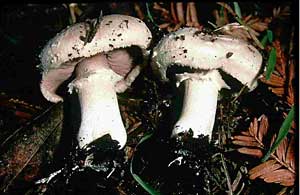Agaricus bisporus is a soil-growing homobasidiomycete fungus that plays an ecologically significant role in the degradation of leaf and needle litter in temperate forests. Soils contain humic compounds derived from modified lignin and other recalcitrant aromatic compounds, and represent a different catabolic challenge from the intact woody tissues colonized by many other fungi. Thus, A. bisporus forms an important model for carbon sequestration studies to understand the persistence of mycelial material in humus and to determine the role of fungi in bioconversion of plant materials to humic acids. The homobasidiomycete species is arguably the most well studied member of the family Agaricaceae, a large, diverse and economically important group of fungi. Comprehending the carbon cycling role of the Agaricaceae in forests and other ecosystems is a prerequisite to modeling and optimizing carbon management.

Agaricus bisporus, conifer forest soil, Moss Beach, CA. Photo courtesy R.W. Kerrigan.
Agaricus genome sequence will provide new opportunities to compare the role of a secondary decomposer in various environmental and developmental fungal processes with other basidiomycetes and ascomycetes. Comparisons with the sequenced Polyporales (Postia placenta –brown rot, and Phanerochaete chrysosporium–white rot) and the mycorrhizal basidiomycetes will provide insight into transitions between different ecological modes (e.g. decomposer, mycorrhizal, white- and brown-rot fungi).
As a leaf-litter degrader, A. bisporus grows very well in lignocellulosic composts and is able to degrade lignin, but the enzyme system it uses for lignin degradation is not fully characterized. Sequencing A. bisporus will improve our knowledge of the mechanisms it uses for efficient conversion of lignocellulose and provide information to underpin development of effective biofuel strategies.
Fortunately, as the premier cultivated mushroom species, a substantial scientific knowledge base exists for A. bisporus, which forms a solid foundation from which to launch comparative analyses of basidiomycota genome sequences. Physiology, metabolism, and development have all been investigated at the molecular level. Significantly, several Agaricus species have potential for bioremediation of substrates contaminated with heavy metals, and these decomposer fungi are more able to hyperaccumulate toxic metals than some mycorrhizal fungi. Full potential of this area will require more extensive research, and all these areas would be expedited by the availability of genome sequence.
Principal Investigator: Mike Challen (Univ. of Warwick)